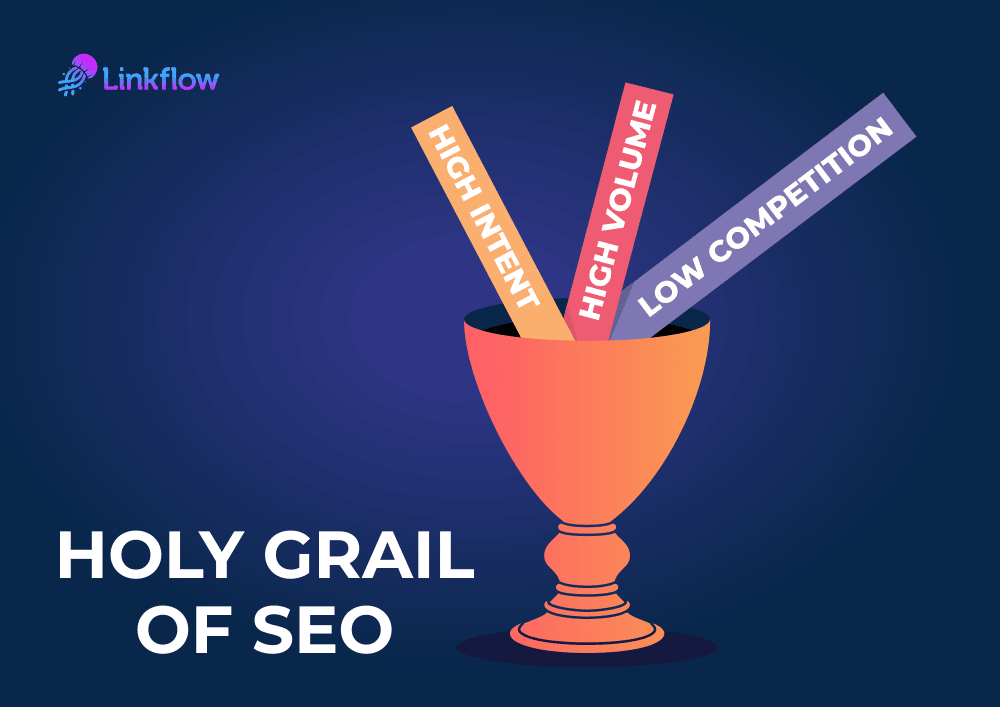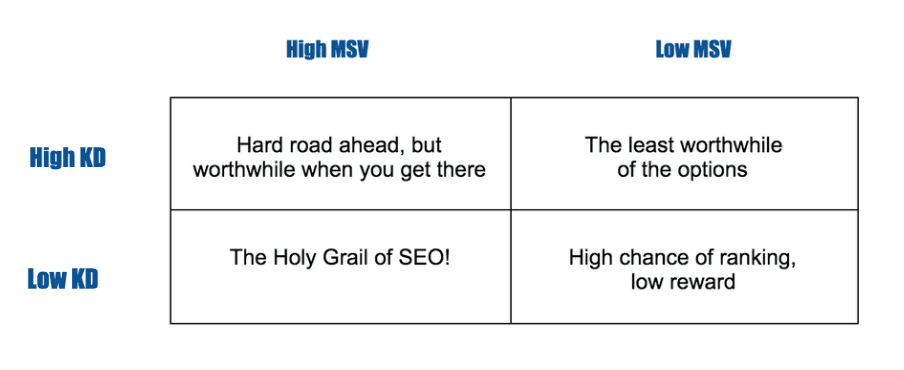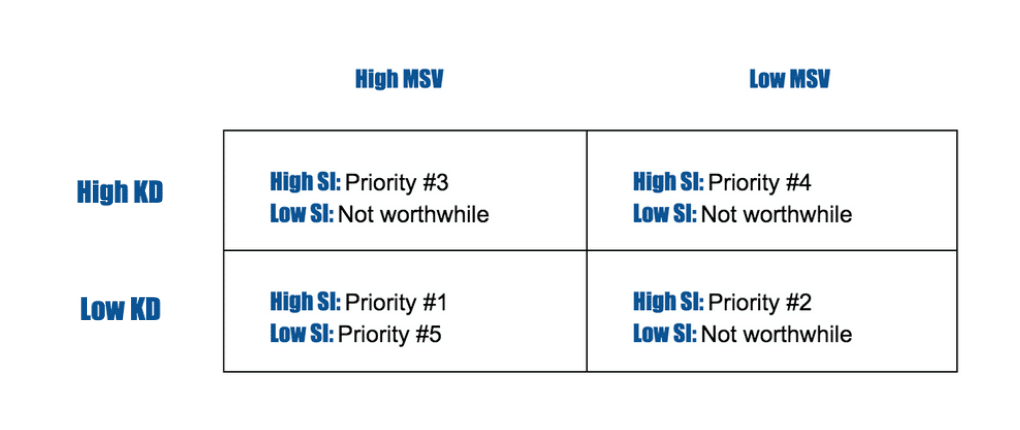
It’s not uncommon to focus on metrics like monthly search volume (MSV) and keyword difficulty (KD) during an initial evaluation of keywords to target. With only those two criteria taken into account, you could use a matrix like this to prioritize keywords for your content strategy:

But there’s a third factor that’s more difficult to quantify but arguably the most important: search intent.
Search intent is the end-game for any user-search. Do they want to learn more about a topic? Is there a specific website they’re looking for? Better yet, are they ready to purchase?
Let’s take a look at three types of search intent, as well as some examples of each so you can evaluate keywords with a more discerning eye. Along the way, we’ll see how high levels of search intent can make keywords with low search volume our most worthwhile targets.
Three types of search intent
Transactional intent
Transactional search intent refers to the user’s readiness to complete an action, such as making a purchase or scheduling a phone call.
Sample keywords with transactional intent:
- Used ford mustangs for sale
- Nashville plumbers
- Buy baby wipes in bulk
Informational intent
Most searches conducted fall into the category of informational intent, given the vast amount of information available on the internet. Simply put, the user is looking for information.
Examples of keywords with informational intent:
- How to make a grilled cheese?
- Lima, Peru
- What are the three branches of government?
- Beyonce net worth
Navigational intent
Users with navigational intent are in search of a specific website. Rather than type a potentially faulty URL into the browser bar, they enter the company name into a search engine field to get there faster.
Many of the most highly searched keywords indicate navigational intent:
- YouTube
- BuzzFeed
Arguably, search intent for some keywords overlaps. Fortunately, search engines understand that and provide a mix of results to satisfy each by generating “mixed intent SERPs,” which group websites with similar intent together. For example, a search for “best portable speakers” presents multiple listings for third-party review sites like CNET. Sites like these give users still in the research stage helpful information about the different types of speakers available on the market.

Big box retailers like Best Buy also appear on SERPs to satisfy users with transactional intent.

The best keyword targets for search intent
See if you can identify keywords with high levels of search intent in the examples below. MSV and KD values for all are purely fictional for illustration.
Company: The Ultimate Diet Pill Company
Goal: Increase sales of plant-based diet pills

In spite of its lower monthly search volume, the second group of keywords (“best diet pills…”) should be your first priority since it’s highly focused, demonstrates transactional intent, and most likely to drive traffic and conversion. That’s not to say ranking for “how to lose weight” isn’t worthwhile, but the keyword target will attract a higher-funnel user. A secondary or tertiary priority might be to create blog content that explains weight loss methodologies and objectives to attract users who are still doing their homework.
Company: Blenders Unlimited
Goal: Increase sales of flagship blender

Users searching for smoothie recipes probably have a blender. Some may be willing to upgrade, but how many? “New kitchen checklist” seems more likely to be of greater value since those searchers are in the market for new kitchen equipment, even if the search volume is significantly lower.
Even so, let’s say (hypothetically) that 2% of “avocado smoothie” searchers and 5% of “kitchen checklist” searchers buy a blender. In that case, the keywords have equal value because they each generate 180-unit purchases. Since it’s difficult to accurately predict conversion rates based on user intent alone, we can’t say definitively which keyword is better.
A good way to identify searcher intent is by looking closely at your SERPs. If the majority of listings for a specific keyword align with your website intent, then it’s a good target keyword.
Company: Business Intelligence Consultants, Inc.
Goal: Increase number of consultations calls

Users searching for “BI consulting services” are the perfect prospects for this company, but it’s hard to look past a high keyword difficulty. Unless the company’s website has a robust link profile, it will be difficult to rank on page 1 for the keyword.
Users who conduct churn rate analysis in-house but are searching for guidance might be convinced to hire a BI consultant, but they’re not as warm a prospect as the “BI consulting services” searcher. Given its lower KD, it’s a better keyword to target in the short run.
Company: Tweezer Supply
Goal: Increase tweezer sales

“Pink tweezers” is clearly a high search-intent keyword, but even a 5% conversion of “how to remove a splinter” searchers will deliver a greater ROI than 100% of “pink tweezer” search purchases.
Putting search intent in better context
Now that we’ve looked at the interrelationships between search intent, KD, and MSV in assessing keyword value, our matrix takes on new meaning and better context. For example, if a keyword has low KD and low MSV, you’d check the bottom right cell to see how and if to prioritize this keyword based on the level of search intent.

‘It depends’
SEO’s favorite mantra also applies to search intent! Even though there’s no one-size-fits-all formula for assessing the best keyword targets, a good understanding of search intent will put you in a better position to prioritize keywords to attract high-value traffic for greater ROI and revenue growth.
Michelle Fayssoux, SEO Analyst
Michelle is a proud Orange County, California native with many years of experience helping clients improve their organic search performance. She has supported companies spanning a wide range of industries, including tech startups, e-commerce sites, and major SaaS brands. When she’s not writing about SEO or chatting with clients, she enjoys traveling, visiting local breweries, and staying active with her two dogs.
